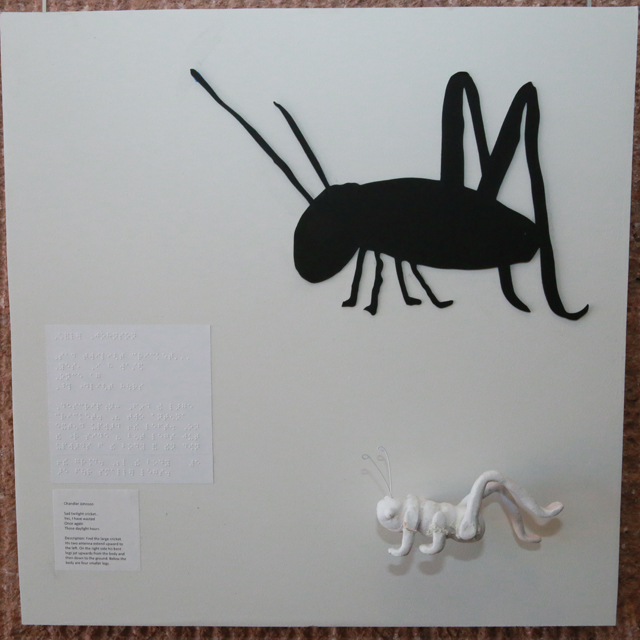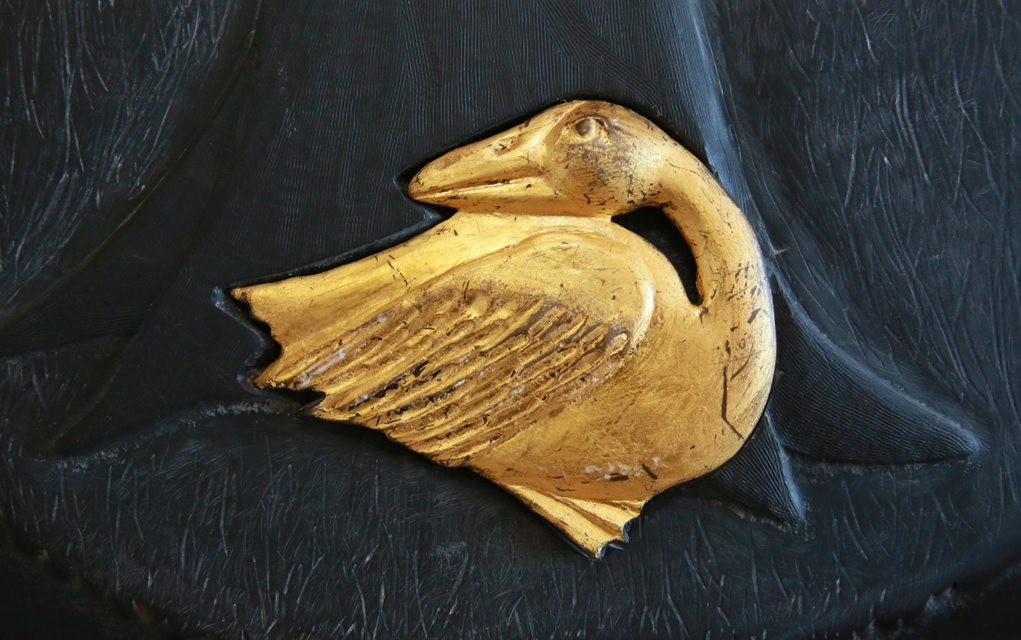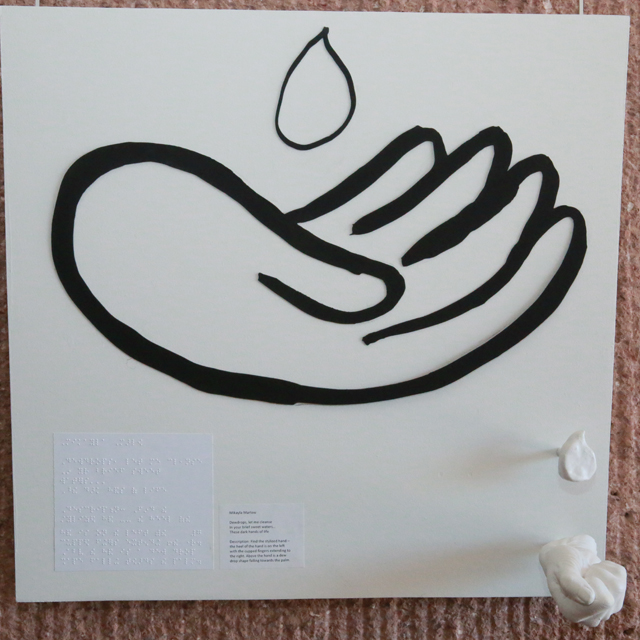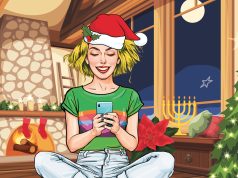
Ann Cunningham was born in the gravel capital of the world, Oxford, Michigan. Surrounded by a variety of rocks, she’d spend hours sorting through stones as a child. When she was 15 her father brought home a book of 101 art projects and one in particular caught her attention.
“There was stone carving, and it was just a two-page spread, but I was like, ‘That’s what I want to do!’” she says.
For the next several years Cunningham worked with a variety of materials. She moved to Colorado in 1968, and one day, while working at Western Sculpting in Denver, she stumbled upon what would become her preferred medium: slate. The smooth texture drew her in, and because of its composition of fine crystals, slate allows Cunningham to create precise textures in her art.
It wasn’t until the early ’90s, when she was setting up an exhibit at Naropa University, that she had an a-ha moment.
“I was hanging it up on the wall, and then I was like, ‘I wonder if someone who is blind could figure out what the picture is,’” she says. “And my whole career changed right then. It was like, boom.”
Since then, Cunningham has immersed herself in the blind community, creating art for people who are visually impaired and teaching art to students at the Colorado Center of the Blind.
Cunningham’s work is currently featured at the National Center for Atmospheric Research (NCAR) in one of two new exhibits that focus on tactile art and experiencing art through touch, on display through Dec. 2. Also featured is the mixed media of art students from Arapahoe Community College, as a part of their continued partnership with the Colorado Center for the Blind.
A learning curve
Soon after Cunningham’s epiphany in the early ’90s, she curated another show called By Touch Alone. She put out a nation-wide call and received a number of entries.
“And I remember in particular this one piece,” she says. “It came in a cardboard box. We pulled it out. It had a string hanging onto a piece of cardboard and it was warped, and it had what looked like meringue dried on the surface. I was like, ‘Well, I don’t know about this…’
“But then I remembered, wait, the whole thing is about touch alone. So I closed my eyes and I touched it, and I was immediately at the seashore. I could feel the sand and the waves and the seaweed, and the driftwood. It was so cool.”
There was a learning curve in making art for people who are blind, Cunningham began to realize. So she sought help straight from the source, showing up to the Colorado Center for the Blind and asking how her art could be more accessible for people without sight.
She learned multiple lessons, as evidenced in her work at NCAR. In part of her exhibit, she has a series of five panels telling the fairy tale of The Golden Goose. They feature a variety of characters and locations, all unique in their feel.
There are multiple textures that distinguish between elements — the tree has more-defined and uniform lines, while the grass is composed of bigger strokes; a character’s boots feel different than his pants that feel different than his shirt. And Cunningham uses different materials — the castle is stone, while the town is made from wood.
In the panels, objects are separate from each other. In one, an ax is lying on the ground as opposed to leaning against the tree, “because it’s hard to tell when you’re coming onto one object and when you’re going on to another,” Cunningham says.

Characters are carved deeply into the slate and limb placement can tell the person’s body position.
“If you have people where you can feel their head, their feet and their hands, then you can generally tell what their body is doing in between,” she says.
The choice of using stories isn’t coincidental. Cunningham frequently illustrates fairy tales to provide context for the viewer. Braille also accompanies all her pieces so people who are blind can follow along.
Taking into consideration
On the other side of the NCAR exhibit hangs the art from sighted students of Arapahoe Community College (ACC). Led by their teacher Nathan Abels, and with assistance from Cunningham, the students created tactile works based off of haikus. Cunningham approached Abels about sharing the show with her, and he jumped at the opportunity.
Inspired by a summer trip to Japan, Abels had his students create simple ink drawings to illustrate haikus about small moments in nature. The drawings were later laser cut out of matboard, slightly rising off the page to create what Abels calls a two-and-a-half dimensional texture. When discussing the projects with Cunningham, Abels realized he might need to provide more context.
“I was talking to her about one of the pieces, a bird on the tree branch,” he explains. “I said that we have this cut out drawing and there’s a downward leaning tree branch. You follow your fingers down the tree branch, down to the bird and you can feel the bird on the tree branch. She said, ‘That’s great but how do you know you got to the bird?’
“That’s me assuming that everyone knows what a bird shape is. And she asked, ‘Have you held a raven? Have you held a magpie?’ And of course I haven’t. So I thought we may need a little more information to flesh out this idea for someone who is blind. That’s where the ceramic part came in.”
Abels reached out to ACC ceramics students to add small, simple sculptures jutting from the bottom of the canvas. The haikus are also written in Braille, as is a description of the cut out drawing.
“[Cunningham] helped me with that part,” he says. “They’re very direct: There’s leaves in the corner and they’re arching up and to the left. It gives somebody a point of reference if they’re experiencing the piece by touch.”

For sighted people, closing their eyes and appreciating a work of art solely through touch can seem overwhelming. Rarely is touch the first sense they use to gain information. So when going through any of the pieces in the NCAR exhibit, sighted people can quickly become lost in the details, unable to create a mental picture of what they’re feeling. The skill is called tactile literacy, and it’s something people who are blind must learn in order to maneuver through daily life.
“The difference between using your fingers and your eyes for information is that your fingers have hundreds of nerve endings. Your eyes and retinas have thousands of nerve endings,” Cunningham says. “So you can see finer detail than you can feel. So it’s not an issue of can someone understand this complex information, it’s if they can feel it. If you learn how to interpret it, you can understand it.”
However, in most modern museums hangs the same sign, “Please don’t touch the art.” It’s a seemingly logical request but serves as a roadblock for the blind community.
A whole new world
“Growing up as a blind child, I never actually really liked art very well because I didn’t have that much access to it,” says Julie Deden, director of the Colorado Center for the Blind (CCB). “And for me, I didn’t really feel like drawing something I couldn’t see or do things I couldn’t do. It was never really fun for me. It wasn’t really so fun going to a museum where other people would describe things to me either.”
Deden has been director for 18 years, and she was there in the late ’90s when Cunningham approached the CCB for help in creating her artwork. Deden calls the move unprecedented, as an artist had never approached them before, and Deden herself didn’t have a relationship with art.
“With Ann, it’s really turned that all around for me,” Deden says. “I really enjoy art. I really love it now.”
For Deden, it’s all about the details she’s able to glean from Cunningham’s art.
“It’s pretty amazing to be able to touch something and maybe know what it is, but also get the feel of it all,” she says. “But it’s more than just knowing. Let’s say, you know there’s a girl sitting in a chair, it’s the details that you get: The girl has long hair. It’s in pigtails. There’s a beautiful sky behind her and the moon is there and there’s a tree and a chair.
“With Ann’s art, you get the whole feel of it all,” she continues. “It definitely paints a scene. I think in some ways the tactile art I get from Ann would be like for [sighted people] looking at a beautiful painting.”
Many people who are blind approach Cunningham’s work without ever having had sight. In that case, grasping the notion of a picture can be difficult. Cunningham tells the story of bringing her friend, who has been blind since birth, to one of her exhibits several years ago.
As they drove closer to the museum, Cunningham’s friend became apprehensive.
“She was like, ‘I don’t like museums. I get there and at best they have Braille labels and that does nothing for me. I could sit at home and read Braille labels,’” Cunningham recounts.
To settle her friend’s nerves, Cunningham explained that the show also had Braille explanations, not just labels. When they arrived to Cunnhingam’s exhibit telling the story of Giricoccola, essentially the Italian version of Cinderella, her friend quickly found the Braille and started to read aloud, gaining the attention of the other museum goers. She then left the Braille and started feeling one of the panels.
“[She started] going back and forth between the Braille and the artwork, connecting them. The lights came on,” Cunningham says with a snap of her fingers. “It still gives me chills. All of a sudden she got what a picture was.”
Cunningham saw her friend immerse herself in the art, even making playful suggestions of parts of the story that Cunningham should have illustrated. She explains the significance of this using the example of fruit.
“If you’ve never had an apple, you can understand that an apple is a fruit and it’s crisp,” she says. “But if you’ve never bitten into one, you don’t know what an apple is, and it’s sort of the same for pictures, until you’ve seen one you haven’t seen one.”
Over the years, Cunningham’s work opened doors that were previously closed for people who are visually impaired. Deden says it allows her to be an active participant, no longer experiencing museums and art through descriptions from other people.
“It’s all about being an active participant, I would say. Being a full part of something, that is really wonderful. …” Deden says. “That’s one thing we teach our students is that piece of it all, that you should be an active participant in all parts of your life.”
Bridging the gaps
Cunningham began teaching at CCB in 1999. Teaching students who are blind how to make art was another process that she had to learn. She got her first lesson quick. Early on in her relationship with CCB, she was asked to help make a model of a floor plan for a convention they were holding.
“This one man, he was such a gift for my interaction in this teaching situation,” Cunningham says. “Because he would say, ‘We need to make stairs to represent the escalator. How would you do that?’”
Cunningham chose popsicle sticks and started to build the escalator.
“He said, ‘OK, show me how you’re doing that.’ And so I was getting very flustered, and he said, ‘OK Ann, just settle down, just make the stairs how you usually would, then close your eyes and make them again. Figure out how to do it with your eyes closed, then show me how you’re doing it.’ That was so cool because that’s the main technique I use with my students still.”

That wasn’t the only lesson Cunningham learned. For her first lesson with her students, she chose a familiar medium, stone carving. She brought in alabaster, rasps and files. She also brought in a hammer in case she needed to remove a large chunk of stone for anyone.
“We get started and everybody’s working away,” Cunningham says. “Then somebody needed something big knocked off, and I said, ‘OK, let me do that.’ As soon as I started hammering [the students] were like, ‘What are you doing?’ And then I knew that I had to teach everything.”
With this perspective, she quickly found that stone carving was easy to teach to students who are blind — no accommodations or special techniques are needed. Since then Cunningham has gone on to teach several other disciplines and essential art concepts to people who are blind.
Beyond the canvas
Sighted people often underestimate the amount of knowledge they take in from visually going through the world. But it’s tactile representation that can provide informational details for people who are blind.
“Ann’s done some things in scale,” Deden says. “Maybe she’ll make a picture, she might have a dog with a person walking and you can understand the size of the dog. Or maybe you have a bear next to the dog, and you can see, ‘Oh wow, this bear is so much bigger than that dog is.’
“Sighted people, they end up picking up things all the time because the world is so visual,” she continues. “So they’ll just automatically see something and their brain just files it away. But that’s why tactile literacy is even more important.”
It’s a simple but often overlooked concept. It’s a notion Deden says she doesn’t necessarily think about often until she’s reminded.
“It’s kind of like my son, he’s sighted,” she says. “I never really taught him how to make a grilled cheese sandwich. But of course he just learned how to do it, and the way he learned how to do it is by watching me, I’m sure.
“Whereas with a blind person, and we talk to parents a lot about this, they need to show the blind child this is how to make a grilled cheese sandwich, because they’re not going to be able to watch and just learn that way.”

Outside of the artistic purpose, Cunningham stresses her work can also be informational. She calls art and information two sides of the same coin. One of her pieces in NCAR is a skeletal representation of a small bird of prey, the Mississippi kite.
“I feel like that it is very informative. It’s really accurate … I did my research down at the Museum of Nature and Science,” she says. “A student can really look at that and figure out what is what. I should do another one of a human body so that you can compare the two, because they are very comparable. The part up at the tip of wing is a fused hand bone, there’s the thumb, the wrist, those bones are all analogous to ours.”
Cunningham is a champion for tactile graphics. In terms of education, she says, textbooks typically used to be primarily text, but now they’re relying more on images. As our world becomes increasingly reliant on digital technology, information becomes almost completely visual. Cunningham stresses the importance of making the information tactually accessible.
“So we have tons of visual graphics that people get information from, but we haven’t kept up with that in the tactile world,” she says. “Braille is equivalent to print but we haven’t developed the means to keep up visual graphics with tactical graphics.”
To remedy this, Cunningham and her colleagues are planning to hold multiple symposiums across the nation in the next few months. She’s bringing in educators, museum staff, artists and art enthusiasts to begin creating more communities around both tactile art and graphics.
An exhibit for everyone
When Cunningham curated that first exhibit intended solely for touch, she says it was met by skeptics who missed its value. Yet, she passionately believed in its importance.
“For some reason I knew that if it didn’t work now, it wasn’t formatted properly,” she says, “that I needed to make it better.”
A couple decades later, Cunningham says she sees many more tactile art exhibits and the concept is gaining momentum.

These shows welcome the blind community to spaces that often overlook them. For Abels and his students, working on these pieces and partnering with CCB reminds them to not take for granted the audiences who experience their art.
“I think it’s good for our students to think about the variety of ways that people are going to experience art,” he says. “It’s also just made my students a little more aware of how other people are living their lives, and how other people experience the world. I’ve learned a lot just from going to the Center for the Blind and learning from them and seeing how they experience life and what they notice that I don’t notice. It’s a beneficial relationship.”
Deden stresses the NCAR exhibit is significant for sighted people to focus on their sense of touch, and to realize that sight isn’t the only way to experience something.
“Unfortunately in our society people believe being blind is just so difficult, that it’s the worst thing that could ever happen,” Deden says. “There are definitely many people who still really believe that, and we really want to dispel those myths to show everybody that being blind is really not a big deal and you can gain so much in other ways as well. … Hopefully with this exhibit, people will try that out for themselves and realize how much they can take in by touching the pieces as well as looking.”
On the bill: Tactile Art by Ann Cunningham and Mixed Media Art by Nathan Abels. Community Art Program Gallery, NCAR, 1850 Table Mesa Drive, Boulder, 303-497-1174. Through Dec 2. Artist Reception. Saturday, Nov. 12, 1 p.m.














